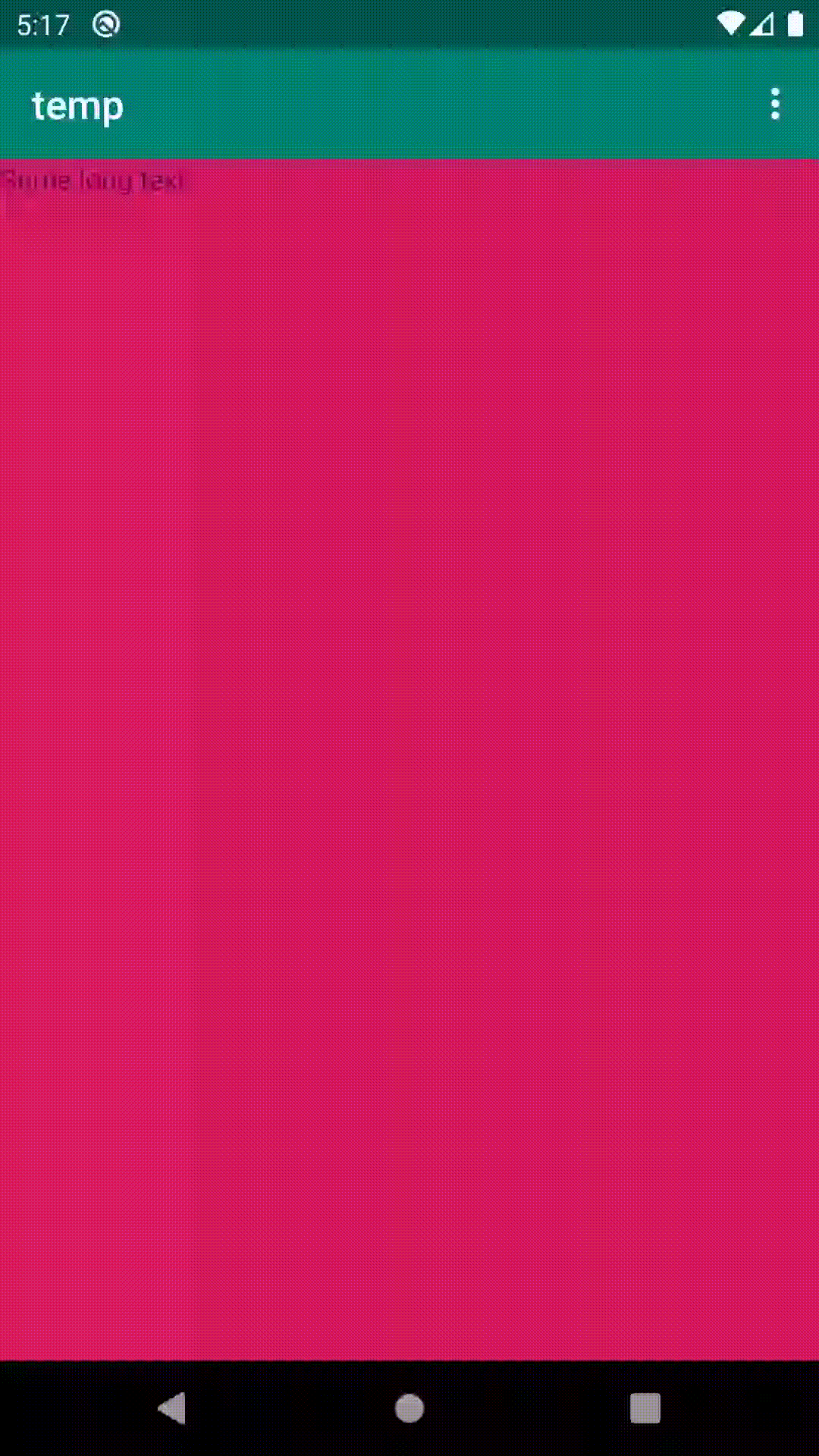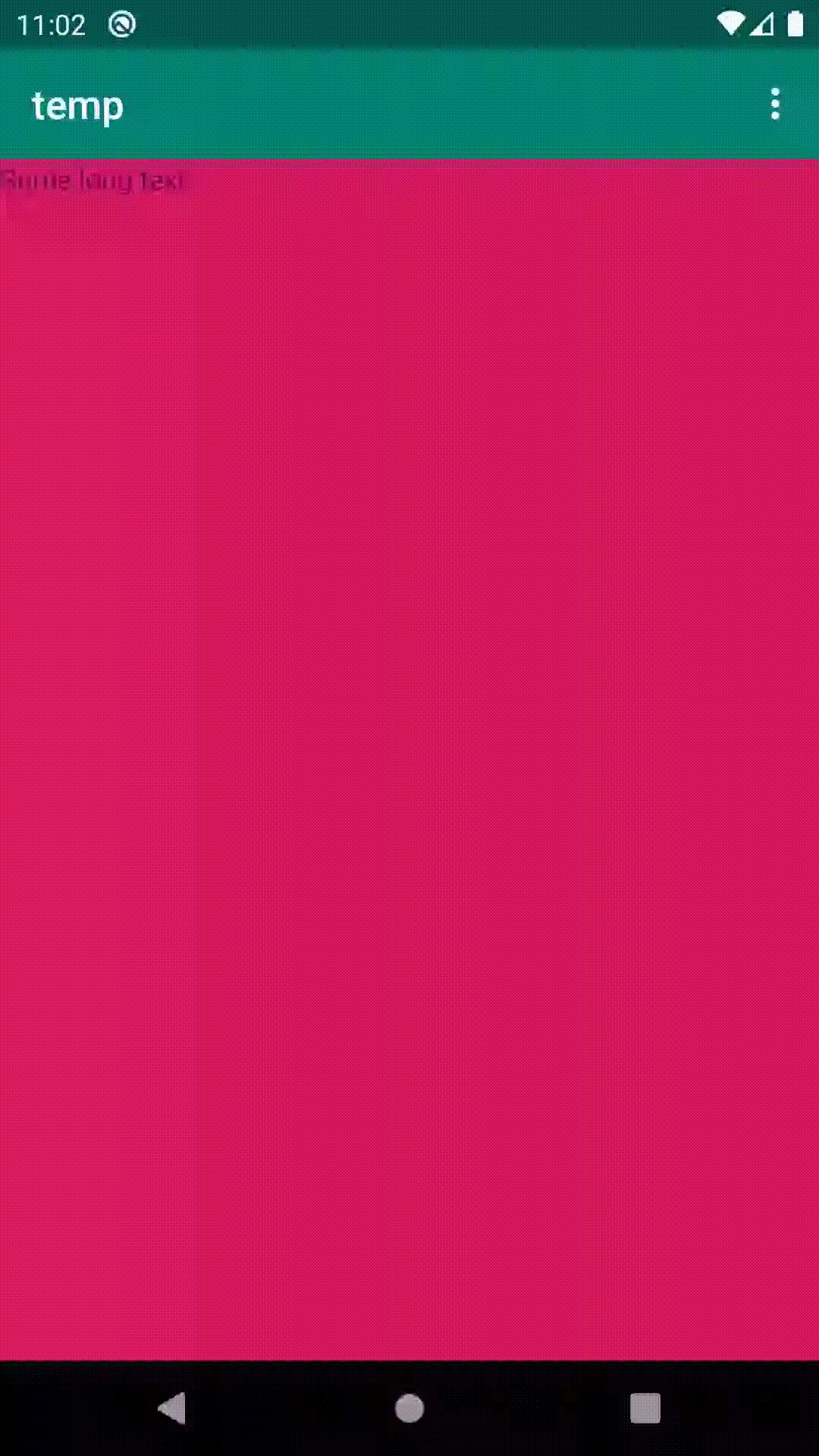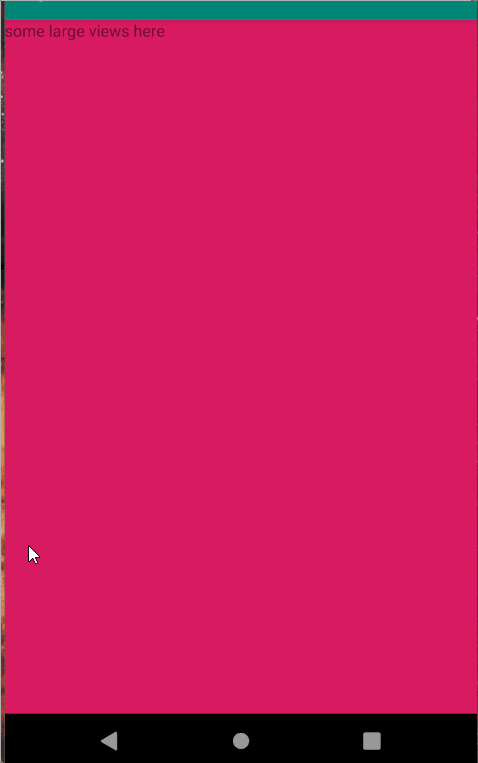Inside a ScrollView I am dynamically switching between two fragments with different heights. Unfortunately that leads to jumping. One can see it in the following animation:
I want both buttons to stay at the same position when switching to the yellow fragment. How can that be done?

Source code available at https://github.com/wondering639/stack-dynamiccontent respectively https://github.com/wondering639/stack-dynamiccontent.git
Relevant code snippets:
activity_main.xml
<?xml version="1.0" encoding="utf-8"?>
<androidx.core.widget.NestedScrollView xmlns:android="http://schemas.android.com/apk/res/android"
xmlns:app="http://schemas.android.com/apk/res-auto"
xmlns:tools="http://schemas.android.com/tools"
android:id="@+id/myScrollView"
android:layout_width="match_parent"
android:layout_height="match_parent">
<androidx.constraintlayout.widget.ConstraintLayout
android:layout_width="match_parent"
android:layout_height="match_parent"
tools:context=".MainActivity">
<TextView
android:id="@+id/textView"
android:layout_width="0dp"
android:layout_height="800dp"
android:background="@color/colorAccent"
android:text="@string/long_text"
app:layout_constraintEnd_toEndOf="parent"
app:layout_constraintStart_toStartOf="parent"
app:layout_constraintTop_toTopOf="parent" />
<Button
android:id="@+id/button_fragment1"
android:layout_width="0dp"
android:layout_height="wrap_content"
android:layout_marginStart="16dp"
android:layout_marginLeft="16dp"
android:text="show blue"
app:layout_constraintEnd_toStartOf="@+id/button_fragment2"
app:layout_constraintHorizontal_bias="0.5"
app:layout_constraintStart_toStartOf="parent"
app:layout_constraintTop_toBottomOf="@+id/textView" />
<Button
android:id="@+id/button_fragment2"
android:layout_width="0dp"
android:layout_height="wrap_content"
android:layout_marginEnd="16dp"
android:layout_marginRight="16dp"
android:text="show yellow"
app:layout_constraintEnd_toEndOf="parent"
app:layout_constraintHorizontal_bias="0.5"
app:layout_constraintStart_toEndOf="@+id/button_fragment1"
app:layout_constraintTop_toBottomOf="@+id/textView" />
<FrameLayout
android:id="@+id/fragment_container"
android:layout_width="match_parent"
android:layout_height="wrap_content"
app:layout_constraintTop_toBottomOf="@+id/button_fragment2">
</FrameLayout>
</androidx.constraintlayout.widget.ConstraintLayout>
MainActivity.kt
package com.example.dynamiccontent
import androidx.appcompat.app.AppCompatActivity
import android.os.Bundle
import android.widget.Button
class MainActivity : AppCompatActivity() {
override fun onCreate(savedInstanceState: Bundle?) {
super.onCreate(savedInstanceState)
setContentView(R.layout.activity_main)
// onClick handlers
findViewById<Button>(R.id.button_fragment1).setOnClickListener {
insertBlueFragment()
}
findViewById<Button>(R.id.button_fragment2).setOnClickListener {
insertYellowFragment()
}
// by default show the blue fragment
insertBlueFragment()
}
private fun insertYellowFragment() {
val transaction = supportFragmentManager.beginTransaction()
transaction.replace(R.id.fragment_container, YellowFragment())
transaction.commit()
}
private fun insertBlueFragment() {
val transaction = supportFragmentManager.beginTransaction()
transaction.replace(R.id.fragment_container, BlueFragment())
transaction.commit()
}
}
fragment_blue.xml:
<?xml version="1.0" encoding="utf-8"?>
<FrameLayout xmlns:android="http://schemas.android.com/apk/res/android"
xmlns:tools="http://schemas.android.com/tools"
android:layout_width="match_parent"
android:layout_height="400dp"
android:background="#0000ff"
tools:context=".BlueFragment" />
fragment_yellow.xml
<?xml version="1.0" encoding="utf-8"?>
<FrameLayout xmlns:android="http://schemas.android.com/apk/res/android"
xmlns:tools="http://schemas.android.com/tools"
android:layout_width="match_parent"
android:layout_height="20dp"
android:background="#ffff00"
tools:context=".YellowFragment" />
HINT
Please note that this is of course a minimum working example to show off my issue. In my real project, I also have views below the @+id/fragment_container. So giving a fixed size to @+id/fragment_container is not an option for me - it would cause a large blank area when switching to the low, yellow fragment.
UPDATE: Overview of proposed solutions
I implemented the proposed solutions for testing purposes and added my personal experiences with them.
answer by Cheticamp, https://stackoverflow.com/a/60323255
-> available in https://github.com/wondering639/stack-dynamiccontent/tree/60323255
-> FrameLayout wraps content, short code
answer by Pavneet_Singh, https://stackoverflow.com/a/60310807
-> available in https://github.com/wondering639/stack-dynamiccontent/tree/60310807
-> FrameLayout gets the size of the blue fragment. So no content wrapping. When switching to the yellow fragment, there's a gap between it and the content following it (if any content follows it). No additional rendering though! ** update ** a second version was provided showing how to do it without gaps. Check the comments to the answer.
answer by Ben P., https://stackoverflow.com/a/60251036
-> available in https://github.com/wondering639/stack-dynamiccontent/tree/60251036
-> FrameLayout wraps content. More code than the solution by Cheticamp. Touching the "show yellow" button twice leads to a "bug" (buttons jump down to the bottom, actually my original issue). One could argue about just disabling the "show yellow" button after switching to it, so I wouldn't consider this a real issue.
Update: To keep the other views right below the framelayout and to handle the scenario automatically, we need to use onMeasure to implement the auto-handling so do the following steps
• Create a custom ConstraintLayout as (or can use MaxHeightFrameConstraintLayout lib):
import android.content.Context
import android.os.Build
import android.util.AttributeSet
import androidx.constraintlayout.widget.ConstraintLayout
import kotlin.math.max
/**
* Created by Pavneet_Singh on 2020-02-23.
*/
class MaxHeightConstraintLayout @kotlin.jvm.JvmOverloads constructor(
context: Context,
attrs: AttributeSet? = null,
defStyleAttr: Int = 0
) : ConstraintLayout(context, attrs, defStyleAttr){
private var _maxHeight: Int = 0
// required to support the minHeight attribute
private var _minHeight = attrs?.getAttributeValue(
"http://schemas.android.com/apk/res/android",
"minHeight"
)?.substringBefore(".")?.toInt() ?: 0
override fun onMeasure(widthMeasureSpec: Int, heightMeasureSpec: Int) {
if (Build.VERSION.SDK_INT >= Build.VERSION_CODES.JELLY_BEAN) {
_minHeight = minHeight
}
var maxValue = max(_maxHeight, max(height, _minHeight))
if (maxValue != 0 && && maxValue > minHeight) {
minHeight = maxValue
}
_maxHeight = maxValue
super.onMeasure(widthMeasureSpec, heightMeasureSpec)
}
}
and use it in your layout in place of ConstraintLayout
<?xml version="1.0" encoding="utf-8"?>
<androidx.core.widget.NestedScrollView xmlns:android="http://schemas.android.com/apk/res/android"
xmlns:app="http://schemas.android.com/apk/res-auto"
xmlns:tools="http://schemas.android.com/tools"
android:id="@+id/myScrollView"
android:layout_width="match_parent"
android:layout_height="match_parent">
<com.example.pavneet_singh.temp.MaxHeightConstraintLayout
android:id="@+id/constraint"
android:layout_width="match_parent"
android:layout_height="match_parent"
tools:context=".MainActivity">
<TextView
android:id="@+id/textView"
android:layout_width="0dp"
android:layout_height="800dp"
android:background="@color/colorAccent"
android:text="Some long text"
app:layout_constraintEnd_toEndOf="parent"
app:layout_constraintStart_toStartOf="parent"
app:layout_constraintTop_toTopOf="parent" />
<Button
android:id="@+id/button_fragment1"
android:layout_width="0dp"
android:layout_height="wrap_content"
android:layout_marginStart="16dp"
android:layout_marginLeft="16dp"
android:text="show blue"
app:layout_constraintEnd_toStartOf="@+id/button_fragment2"
app:layout_constraintHorizontal_bias="0.3"
app:layout_constraintStart_toStartOf="parent"
app:layout_constraintTop_toBottomOf="@+id/textView" />
<Button
android:id="@+id/button_fragment2"
android:layout_width="0dp"
android:layout_height="wrap_content"
android:layout_marginEnd="16dp"
android:layout_marginRight="16dp"
android:text="show yellow"
app:layout_constraintHorizontal_bias="0.3"
app:layout_constraintStart_toEndOf="@+id/button_fragment1"
app:layout_constraintTop_toBottomOf="@+id/textView" />
<Button
android:id="@+id/button_fragment3"
android:layout_width="0dp"
android:layout_height="wrap_content"
android:layout_marginEnd="16dp"
android:layout_marginRight="16dp"
android:text="show green"
app:layout_constraintEnd_toEndOf="parent"
app:layout_constraintHorizontal_bias="0.3"
app:layout_constraintStart_toEndOf="@+id/button_fragment2"
app:layout_constraintTop_toBottomOf="@+id/textView" />
<FrameLayout
android:id="@+id/fragment_container"
android:layout_width="match_parent"
android:layout_height="wrap_content"
app:layout_constraintTop_toBottomOf="@id/button_fragment3" />
<TextView
android:layout_width="match_parent"
android:layout_height="match_parent"
android:text="additional text\nMore data"
android:textSize="24dp"
app:layout_constraintTop_toBottomOf="@+id/fragment_container" />
</com.example.pavneet_singh.temp.MaxHeightConstraintLayout>
</androidx.core.widget.NestedScrollView>
This will keep track of height and apply it during every fragment change.
Output:

Note: As mentioned in comments before, setting minHeight will result in additional rendering pass and it cannot be avoided in the current version of ConstraintLayout.
Old approach with custom FrameLayout
This is an interesting requirement and my approach is to solve it by creating a custom view.
Idea:
My idea for the solution is to adjust the height of the container by keeping the track of the largest child or total height of children in the container.
Attempts:
My first few attempts were based on modifying the existing behaviour of NestedScrollView by extending it but it doesn't provide access to all the necessary data or methods. Customisation resulted in poor support for all scenarios and edge cases.
Later, I achieved the solution by creating a custom Framelayout with different approach.
Solution Implementation
While implementing the custom behaviour of height measurement phases, I dug deeper and manipulated the height with getSuggestedMinimumHeight while tracking the height of children to implement the most optimised solution as it will not cause any additional or explicit rendering because it will manage the height during the internal rendering cycle so create a custom FrameLayout class to implement the solution and override the getSuggestedMinimumHeight as:
class MaxChildHeightFrameLayout @JvmOverloads constructor(
context: Context,
attrs: AttributeSet? = null,
defStyleAttr: Int = 0
) : FrameLayout(context, attrs, defStyleAttr) {
// to keep track of max height
private var maxHeight: Int = 0
// required to get support the minHeight attribute
private val minHeight = attrs?.getAttributeValue(
"http://schemas.android.com/apk/res/android",
"minHeight"
)?.substringBefore(".")?.toInt() ?: 0
override fun getSuggestedMinimumHeight(): Int {
var maxChildHeight = 0
for (i in 0 until childCount) {
maxChildHeight = max(maxChildHeight, getChildAt(i).measuredHeight)
}
if (maxHeight != 0 && layoutParams.height < (maxHeight - maxChildHeight) && maxHeight > maxChildHeight) {
return maxHeight
} else if (maxHeight == 0 || maxHeight < maxChildHeight) {
maxHeight = maxChildHeight
}
return if (background == null) minHeight else max(
minHeight,
background.minimumHeight
)
}
}
Now replace the FrameLayout with MaxChildHeightFrameLayout in activity_main.xml as:
<?xml version="1.0" encoding="utf-8"?>
<androidx.core.widget.NestedScrollView xmlns:android="http://schemas.android.com/apk/res/android"
xmlns:app="http://schemas.android.com/apk/res-auto"
xmlns:tools="http://schemas.android.com/tools"
android:id="@+id/myScrollView"
android:layout_width="match_parent"
android:layout_height="match_parent">
<androidx.constraintlayout.widget.ConstraintLayout
android:layout_width="match_parent"
android:layout_height="match_parent"
tools:context=".MainActivity">
<TextView
android:id="@+id/textView"
android:layout_width="0dp"
android:layout_height="800dp"
android:background="@color/colorAccent"
android:text="Some long text"
app:layout_constraintEnd_toEndOf="parent"
app:layout_constraintStart_toStartOf="parent"
app:layout_constraintTop_toTopOf="parent" />
<Button
android:id="@+id/button_fragment1"
android:layout_width="0dp"
android:layout_height="wrap_content"
android:layout_marginStart="16dp"
android:layout_marginLeft="16dp"
android:text="show blue"
app:layout_constraintEnd_toStartOf="@+id/button_fragment2"
app:layout_constraintHorizontal_bias="0.5"
app:layout_constraintStart_toStartOf="parent"
app:layout_constraintTop_toBottomOf="@+id/textView" />
<Button
android:id="@+id/button_fragment2"
android:layout_width="0dp"
android:layout_height="wrap_content"
android:layout_marginEnd="16dp"
android:layout_marginRight="16dp"
android:text="show yellow"
app:layout_constraintEnd_toEndOf="parent"
app:layout_constraintHorizontal_bias="0.5"
app:layout_constraintStart_toEndOf="@+id/button_fragment1"
app:layout_constraintTop_toBottomOf="@+id/textView" />
<com.example.pavneet_singh.temp.MaxChildHeightFrameLayout
android:id="@+id/fragment_container"
android:layout_width="match_parent"
android:minHeight="2dp"
android:layout_height="wrap_content"
app:layout_constraintTop_toBottomOf="@+id/button_fragment2"/>
</androidx.constraintlayout.widget.ConstraintLayout>
</androidx.core.widget.NestedScrollView>
getSuggestedMinimumHeight() will be used to calculate the height of the view during the view rendering lifecycle.
Output:

With more views, fragment and different height. (400dp, 20dp, 500dp respectively)

A straightforward solution is to adjust the minimum height of the ConstraintLayout within the NestedScrollView before switching fragments. To prevent jumping, the height of the ConstraintLayout must be greater than or equal to
plus
The following code encapsulates this concept:
private fun adjustMinHeight(nsv: NestedScrollView, layout: ConstraintLayout) {
layout.minHeight = nsv.scrollY + nsv.height
}
Please note that layout.minimumHeight will not work for ConstraintLayout. You must use layout.minHeight.
To invoke this function, do the following:
private fun insertYellowFragment() {
val transaction = supportFragmentManager.beginTransaction()
transaction.replace(R.id.fragment_container, YellowFragment())
transaction.commit()
val nsv = findViewById<NestedScrollView>(R.id.myScrollView)
val layout = findViewById<ConstraintLayout>(R.id.constraintLayout)
adjustMinHeight(nsv, layout)
}
It is similar for insertBlueFragment(). You can, of course, simplify this by doing findViewById() once.
Here is a quick video of the results.

In the video, I have added a text view at the bottom to represent additional items that may exist in your layout below the fragment. If you delete that text view, the code will still work, but your will see blank space at the bottom. Here is what that looks like:

And if the views below the fragment don't fill the scroll view, you will see the additional views plus white space at the bottom.

If you love us? You can donate to us via Paypal or buy me a coffee so we can maintain and grow! Thank you!
Donate Us With